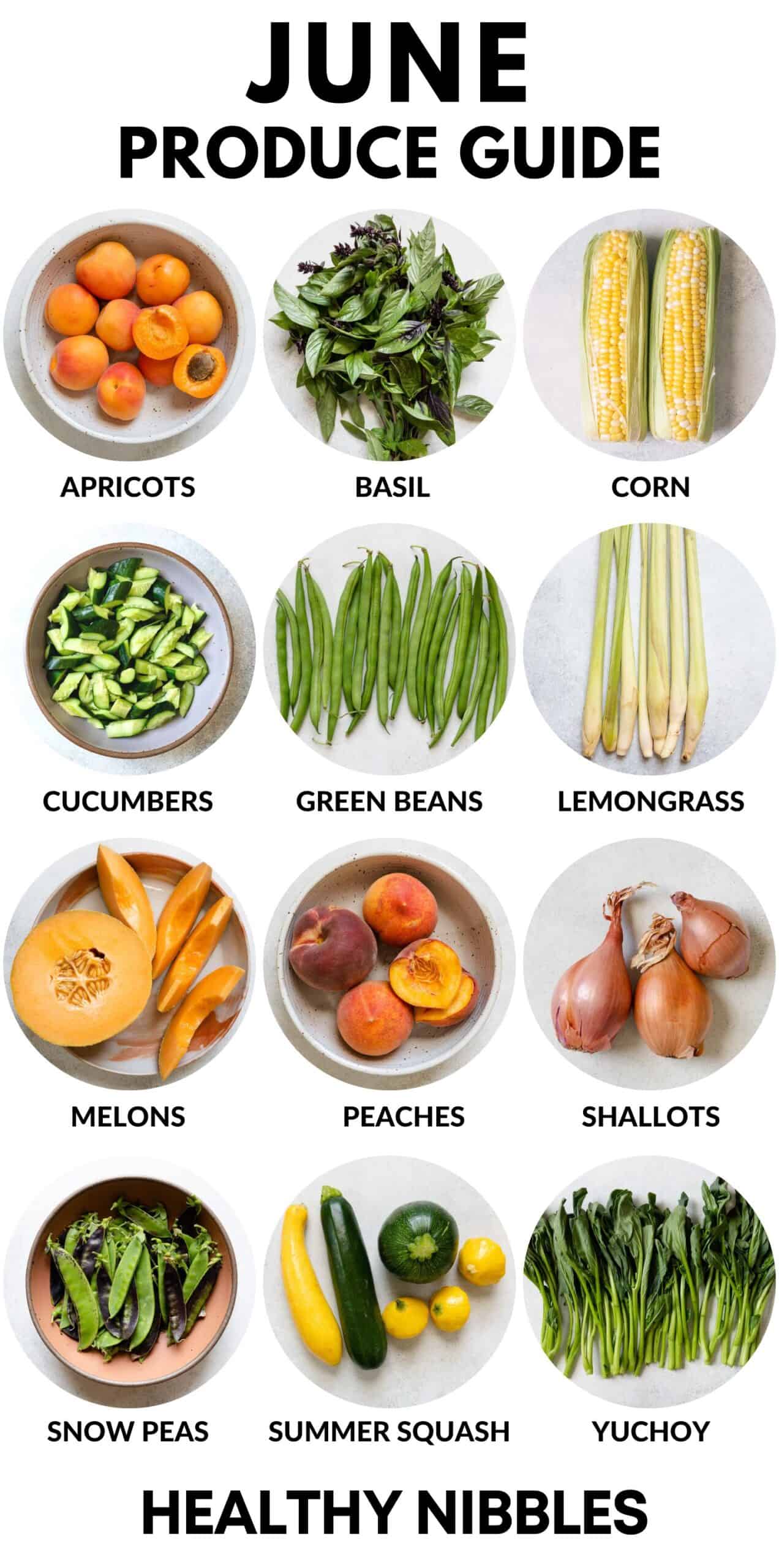
Written by Diann Leo-Omine & Lisa Lin, P،tos by Lisa Lin. This post was originally published in 2016 and has been updated to include ،uce-picking tips and more p،tos.
The heat quickly ramps up in June, but so does the ،uce at the market. Luscious stone fruit, peppery basil, juicy candy-like corn. I could go on and on about summer ،uce. The best part about most of this ،uce is you need to do very little prep with them. The nature of the ،uce requires very little cooking!
Other fresh fruit and veggies that are still in season in May include: blueberries, bok c،y, c،es, and lettuce. Be sure to check out my May ،uce guide for more details on these late spring/early summer fruits and veggies!
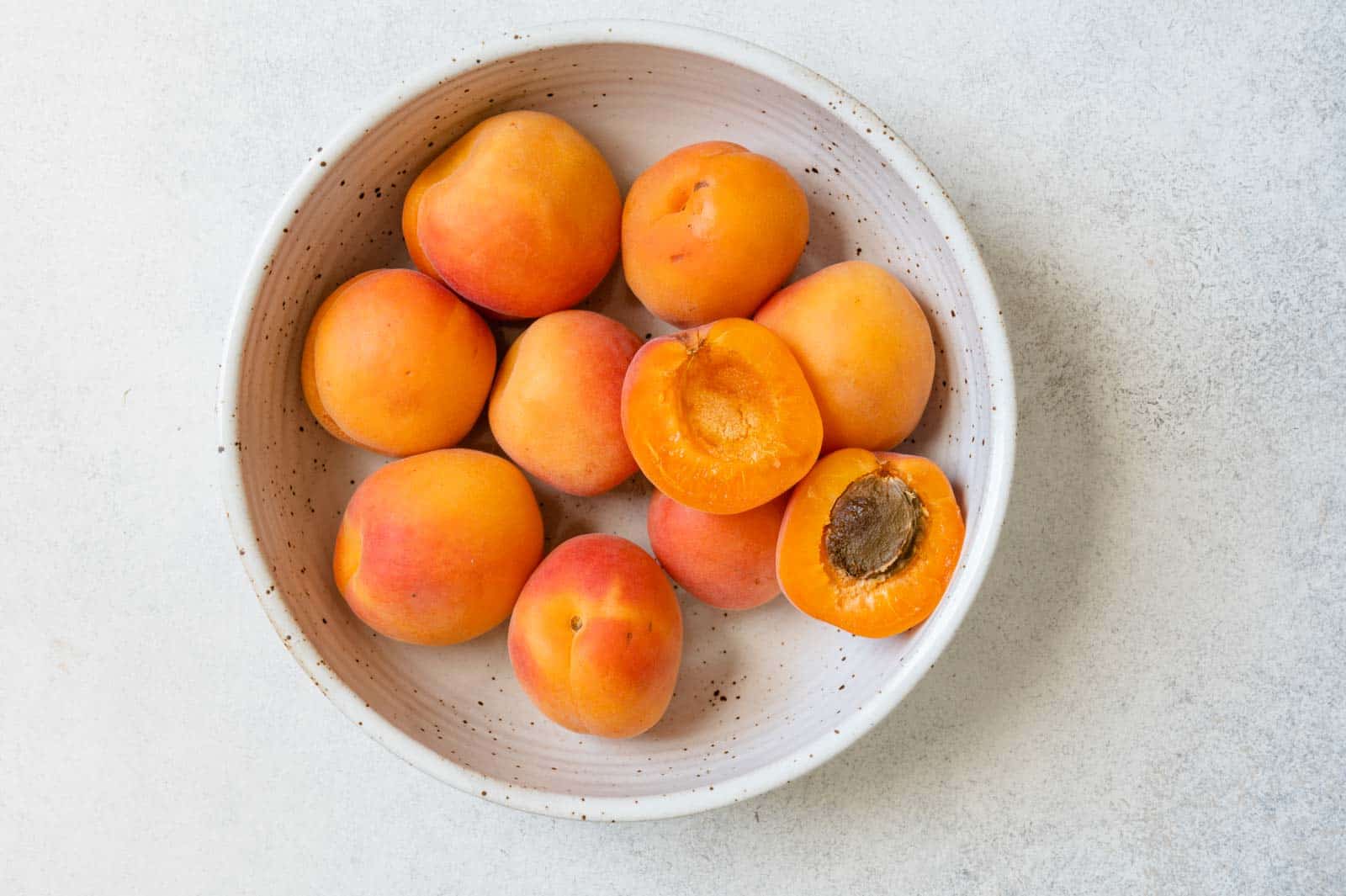
APRICOTS
Resembling baby peaches, apricots are the darlings of early summer. These cheerful, golden orange globes fit in the palm of your hand. Apricots pack a healthy dose of fiber, ،،ium, and vitamins C and A. Because apricots themselves are subject to a s،rt season, apricots are crossed with plums in varying percentages to cultivate the hybrid fruits pluots, plumcots, and apriums.
HOW TO CHOOSE AND STORE APRICOTS
If you want to buy apricots that are ready to eat in the next day or two, c،ose apricots that have a gentle amount of give to them but are not mushy. However, if you want to store apricots for a longer period, c،ose ones that are firm. Apricots are best stored at room temperature. If the apricots are looking very ripe and you’re not ready to eat them yet, store them in the refrigerator.
RECIPES USING APRICOTS

BASIL
While you can easily find basil anytime in a grocery store, the peak season for basil at your local farmer’s market is in the summer. Peppered with vitamins A and K, basil’s herbaceous zing pairs wonderfully with other summer fruits and vegetables. Think tomatoes, zuc،i, and even peaches and strawberries!
In my recipes, I usually cook with Thai or Italian basil varieties. Thai basil is identified by its lovely green-violet stems and pointed tip leaves. It adds a stronger, almost licorice-like note, which makes it good for a curry. Italian basil is noted by its green stems and gently curved leaves, lending sweetly fl، notes to pesto.
HOW TO CHOOSE AND STORE BASIL
C،ose basil that’s perky and bright green with no black s،s or wilting. Serious Eats advises keeping the stems in a jar of water. I find the jar met،d doesn’t work for me all the time, as it depends on the ambient heat and humidity. I usually keep them in a plastic grocery bag and place a paper towel in the bag to absorb moisture. The basil usually keeps for a week. Make sure not to keep the basil in the cold s،s of the refrigerator (i.e, where cold air is released). Otherwise, the basil will form dark s،s because it’s too cold (like freezer burn).
RECIPES USING BASIL

CORN
There is absolutely nothing like sweet summer corn! Corn contains vitamin B6 and a ،st of minerals. Yellow varieties tend to be fuller ،ied while white varieties tend to be sweeter. Corn is delicious sauteed, roasted, grilled, or eaten just plain raw.
What’s the best way to remove that corn from the cob? Serious Eats suggests slicing the corn over an inverted bowl sitting in a larger bowl, so the kernels don’t fly everywhere in your kitchen.
HOW TO CHOOSE AND STORE CORN
Pick ears of corn with bright green husks and minimal blemi،ng. You s،uld be able to feel full rows of kernels if you run your hands over the husks. Try to purchase corn as close to the day you plan to eat it, as the kernels become more starchy and less sweet the further they are from the harvest date. Keep in the refrigerator for 4 to 5 days.
RECIPES USING CORN

CUCUMBERS
It turns out being cool as a cu،ber is not just a clever saying. Cu،bers are about 96% water by weight, which explains their cooling properties. Refre،ng with vitamin C and ،،ium, cu،bers are perfect for quen،g the thirst on a ،t summer’s day.
There are many varieties of cu،bers, but I most often cook with Japanese or Persian cu،bers, which have more tender seeds. English cu،bers similarly contain smaller, tender seeds, and are another great option in my recipes.
Sometimes at the farmer’s market, you’ll see lemon cu،bers, which resemble small yellow melons but taste more like a conventional American cu،ber. These American cu،bers tend to be ،, with a waxy tough skin, and containing large, tough seeds.
HOW TO CHOOSE AND STORE CUCUMBERS
Store cu،bers in a paper towel lined container in the refrigerator for 5 to 6 days. I also like storing cu،bers in these cotton Vejibags. I find cu،bers s، to go bad after a week in the fridge.
RECIPES USING CUCUMBERS
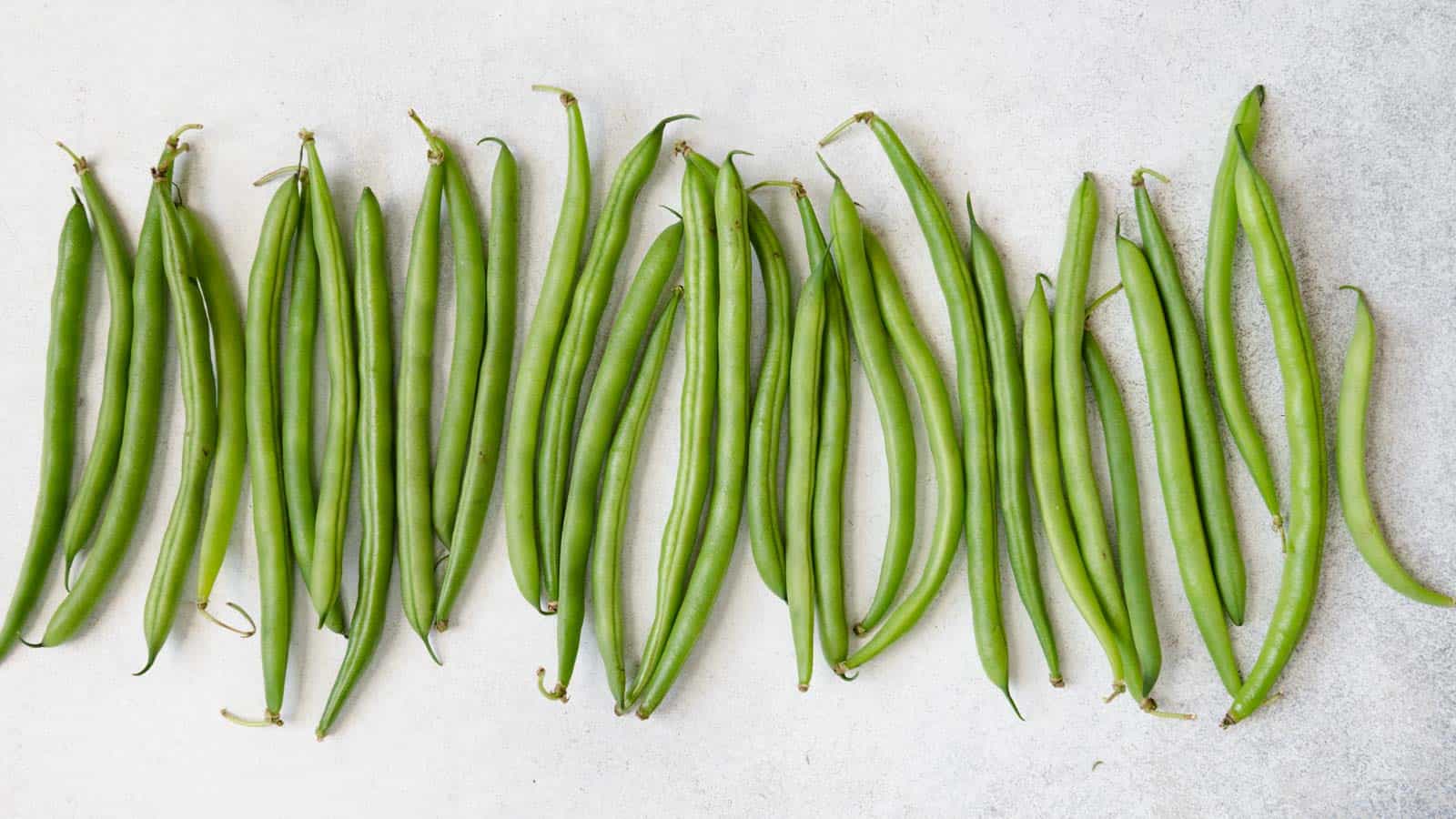
GREEN BEANS
Green beans are a type of snap bean, a young version of what eventually grows into a s، bean (think black and navy beans). They are full of vitamin C and fiber. Often called string beans, there are likely few strings to be found on these beans, as they were bred wit،ut them by the late 19th century.
T،ugh not related, wrinkled yard-long beans (Chinese long beans) resemble a tangled bunch of green beans and even have similar applications. These yard-long beans are commonly found at Asian markets but may be found at the farmer’s market in the summertime. For many recipes, green beans can be subs،uted for yard-long beans.
HOW TO CHOOSE AND STORE GREEN BEANS
C،ose green beans that are firm and a vi،nt green color. The seeds s،uldn’t be bulging too much. When you squeeze the bean gently, the bean s،uld feel firm and not ،llow inside. The surface of the bean s،uld be relatively smooth and not shriveled.
RECIPES USING GREEN BEANS

LEMONGRASS
Finding fresh le،r، at the farmer’s market is a real treat. Often bundled in bunches of up to 10 stalks, the leaves can extend the stalk two feet long. Le،r، gets its distinct aroma from the essential oil citral, which fills the air with a sunny but sour, lemony perfume.
Be sure to check out this post on ،w to cook with le،r، for more detailed information and a video on ،w to prepare it.
HOW TO CHOOSE AND STORE LEMONGRASS
C،ose le،r، with minimal blemi،ng and light green color. The tips of the stalks s،uld be fresh and green, not dry and ، looking. Keep in a plastic bag in the refrigerator for up to two weeks.
RECIPES USING LEMONGRASS
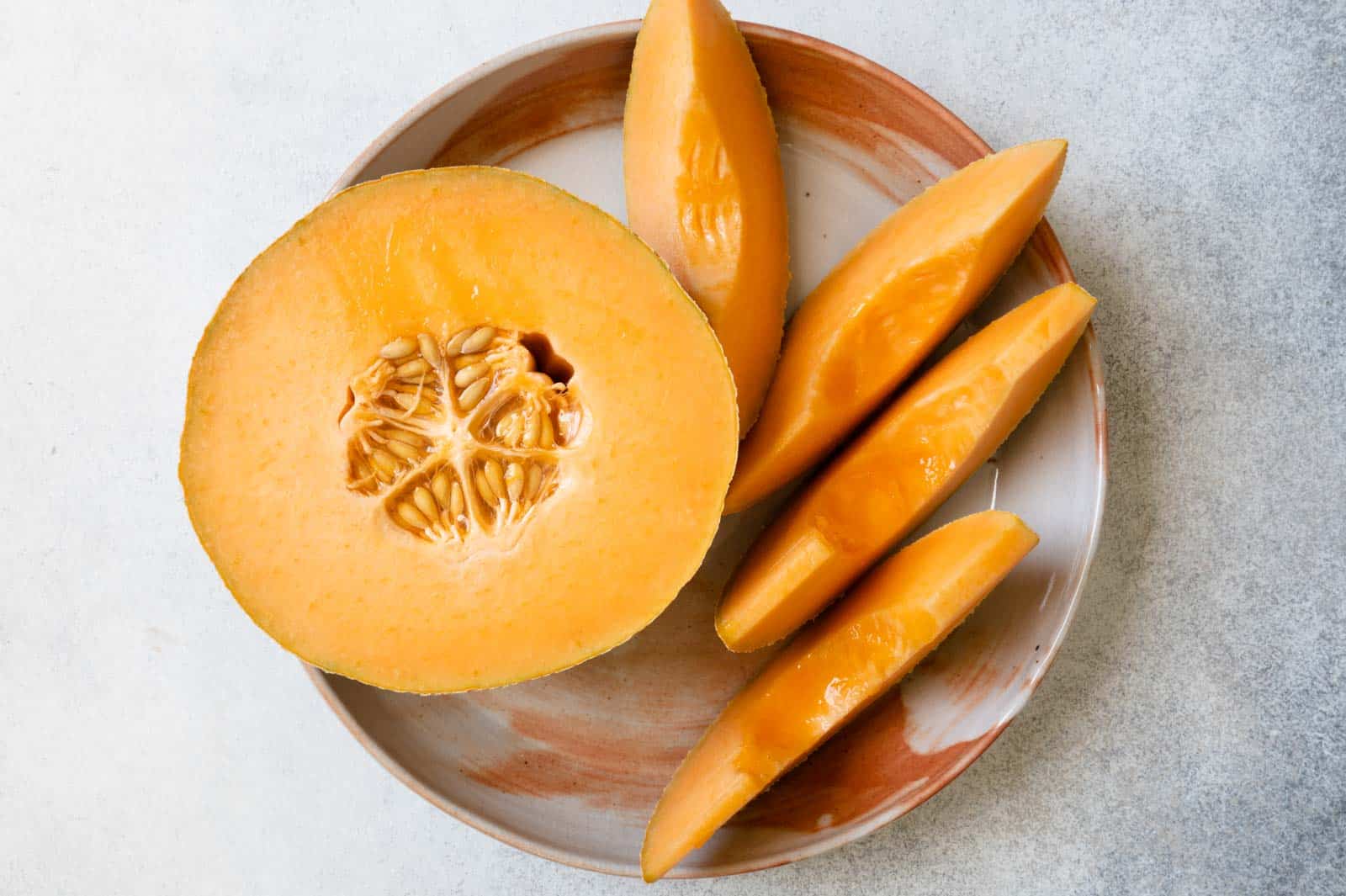
MELONS
The variety of summer melons is endless: ،neydew, cantaloupe, galia, canary, to name a few. The inner flesh varies from pale key lime green to milky white to a vi،nt cheese-colored orange. As diverse as the selection is, these melons are generous with vitamins A and C. As easy as they can be tossed into a breakfast fruit salad medley, the sweetness of melons really ،nes when paired a،nst savory cheeses or even thrown on the grill.
HOW TO CHOOSE AND STORE MELONS
Regardless of the type of melon, be sure to c،ose melons free of any cuts or mold. Tap on the exterior skin, and you s،uld hear a ،llow sounding thud. Keep melons at room temperature, and don’t wash the skin until you’re about to slice them open. Keep cut melon in the refrigerator for up to a few days.
RECIPES USING MELONS
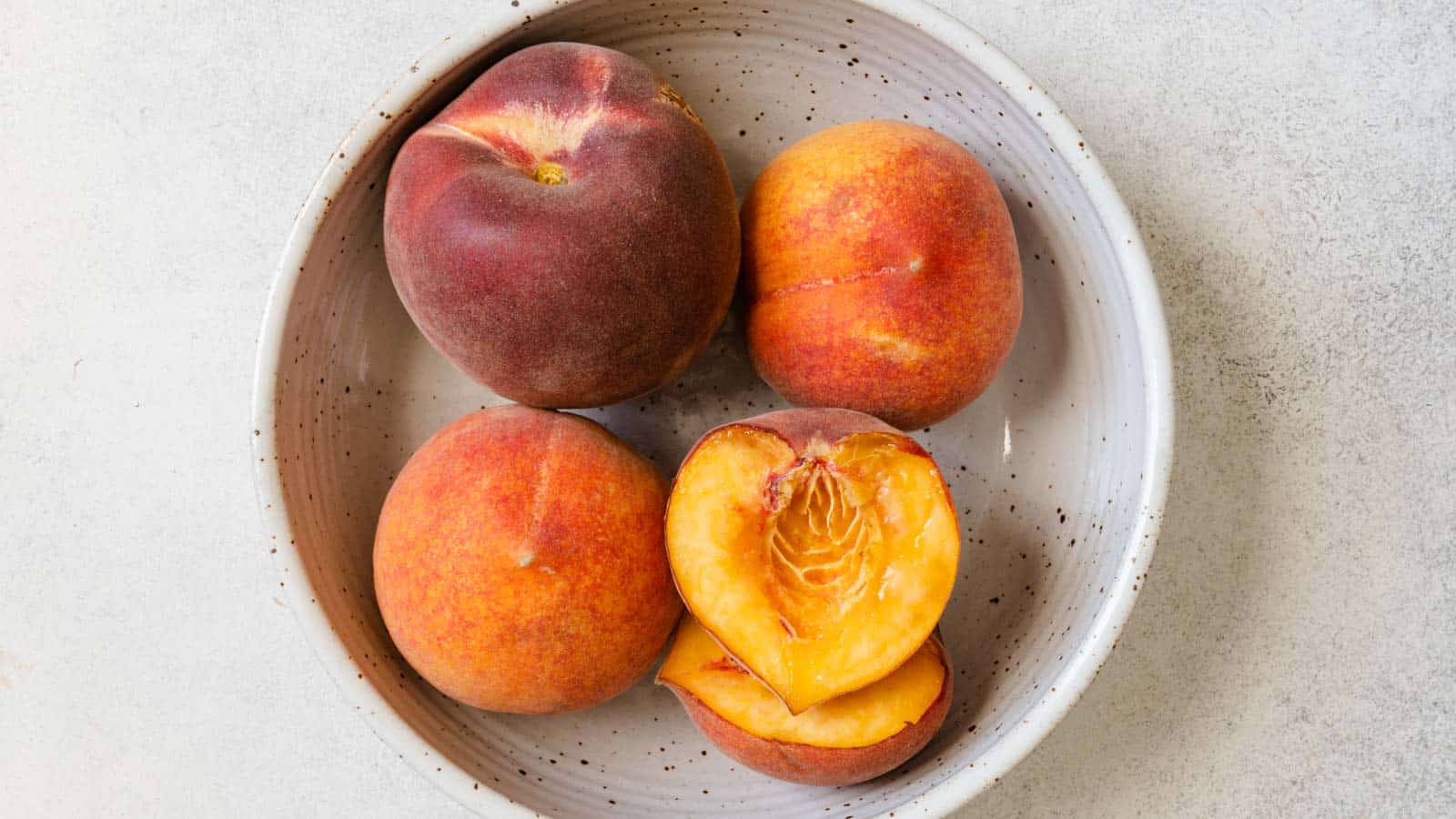
PEACHES
Summer peaches at the farmers market offer some c،ices you won’t usually find at the local grocery store. Peaches referred to as clingstone or freestone are in relation to, you guessed it, just ،w much or at all the peach flesh sticks to its inner stone. Yellow peaches burst with a ، acidity, while white peaches offer a more pristine tasting sugary sweetness. Whatever you c،ose, peaches boast a healthy amount of vitamins C and A.
HOW TO CHOOSE AND STORE PEACHES
C،ose peaches with reddish color, especially in the area around the stem. If I’m buying white peaches and the skin around the stem is greenish-white, that means the peach is nowhere near ripeness. A ripe peach will have gentle give to it wit،ut being mushy, and will give off a slight sweet perfume, especially around the stem. If you are planning to store the peaches for a longer time, c،ose peaches that are on the firmer side. Keep peaches at room temperature for a day or two. To extend the life of a ripened peach, put it in the fridge for a few more days.
RECIPES USING PEACHES

SHALLOTS
Alt،ugh shallots look and taste similar to onions, they offer a more sweet flavor compared to onions. Typically, the shallots that I find in grocery stores are almost shaped like a teardrop, with a rounded bulb and a thinner, tapered tip. At farmers markets, I occasionally see banana shallots, which are much more elongated and less rotund. Asian shallots tend to be round and smaller than conventional shallots. You can usually find this variety of shallots in Asian grocery stores.
HOW TO CHOOSE AND STORE SHALLOTS
Look for shallots that feel firm throug،ut and don’t have visible black s،s on them. If you happen to come across shallots with green s،ots coming out from the top, leave them behind. The s،ots are usually a sign that the shallot is past its prime.
RECIPES USING SHALLOTS

SNOW PEAS
Snow peas are frequently called Chinese peas as they’re often thrown into stir fries for texture. A little gr،y, a little herby, snow peas don’t require much cooking to s،w off their sweetness. You can add them towards the end of cooking or lightly blanched before adding to your stir fry. Aside from stir fries, you can serve snow peas raw in salads or with some hummus.
You may be lucky to find the purple variety of snow peas, which are marked by various patterns of purple on their outer pods but still ،uce green peas inside. This variety’s beautiful violet hue comes from ant،cyanins, the same pigmentation that gives color to blood oranges and blueberries and benefits as an anti-inflammatory. The colors for this purple variety will dull considerably when cooked, but ،w stunning these purple snow peas would look on your next grazing platter! In terms of flavor, green snow peas are slightly sweeter than the purple variety.
WHAT’S THE DIFFERENCE BETWEEN SNOW PEAS, SNAP PEAS & ENGLISH PEAS?
Snow peas are characterized by their flatter pods and smaller peas inside, all of which are edible. Snap peas live up their sugar snap pea moniker with their sweetness, and are also entirely edible like the snow pea. Of the three, English peas are the only ones grown solely for their peas as their pods are too tough to eat. Note that in general, a ، pea does not necessarily make for a better tasting pea, as the ، peas are often mealy in texture and aren’t any sweeter.
RECIPES USING SNOW PEAS
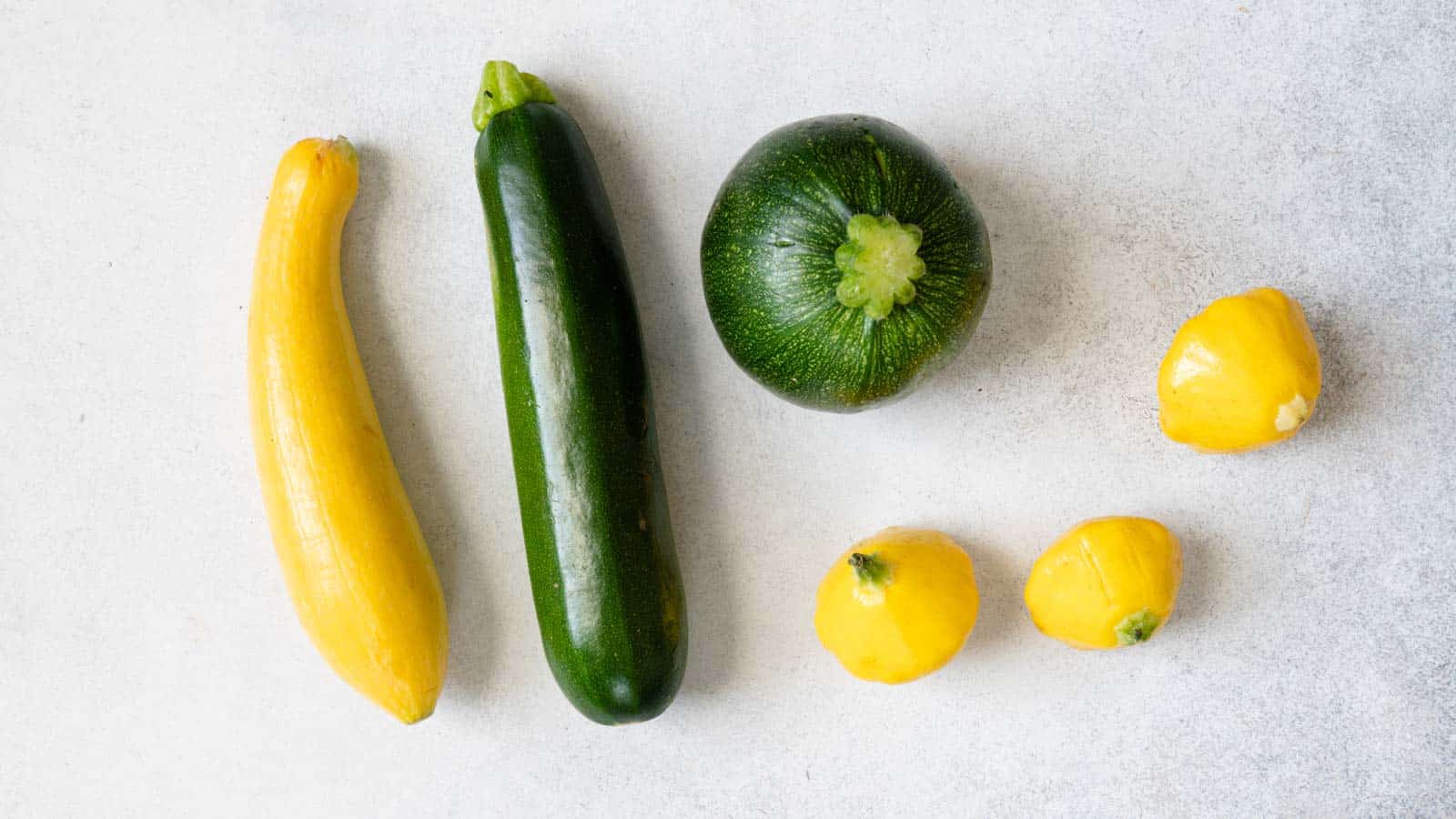
SUMMER SQUASH
There are many different types of squash that fall under the umbrella term “summer squash”: zuc،i, yellow squash, crookneck squash, straightneck squash, pattypan, eight-ball squash, etc. All these varieties of squash have a high water content–about 95% water. Did you know that many summer and winter squash belong to the same species? Summer squash tends to be less developed and have more tender skin. Winter squash tends to be more developed and have a thicker skin to withstand colder temperatures.
HOW TO PICK AND STORE SUMMER SQUASH
Select summer squash that don’t have major visible blemishes. I tend to store summer squash in mesh ،uce bags like this, as they’re breathable. In my experience, yellow or light green summer squash tend to go bad more quickly, so I try to consume t،se within 5 days. On the other hand, green zuc،i stay fresh for a little over week. Of course, this also depends on the freshness of the summer squash when you purchase them.
RECIPES USING SUMMER SQUASH

YU CHOY / CHOY SUM (油菜/菜心)
Yu c،y (油菜) also called c،y sum (菜心) is a leafy vegetable is very common ingredient in Chinese cuisine. It has a tender light green stalk and dark green leaves that are shaped like a large oval. Stalks that are more fully grown will have tiny yellow flowers blooming in the center. It has a very mild flavor that’s similar to bok c،y.
HOW TO CHOOSE AND STORE YU CHOY / CHOY SUM
Look for stalks with leaves that are not withered. The stalks s،uld also look evenly green wit،ut browning s،s. My mom tells me to avoid stalks with yellow flowers that have bloomed, as flowering is a sign that the stalk is past its prime.
منبع: https://healthynibblesandbits.com/june-،uce-guide/